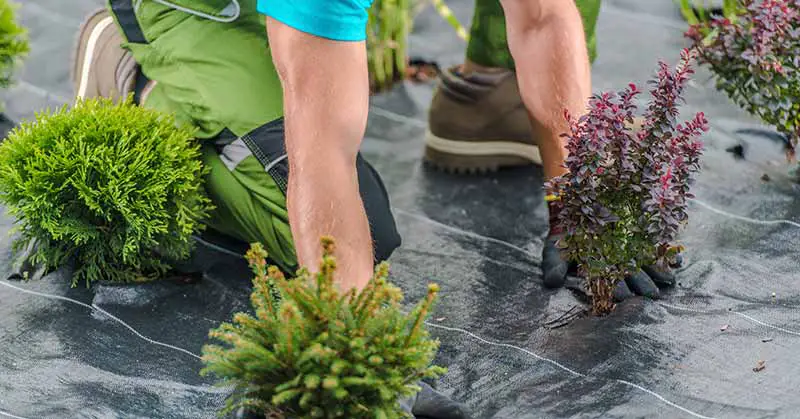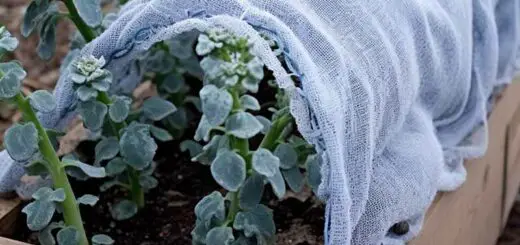Vegetable Garden Landscape Fabric: Tips and Tricks
Last Updated: August 25, 2023
Vegetable garden landscape fabric (weed blocks/weed fabric) can be an incredibly useful tool for vegetable gardening. By laying down a layer of the fabric, you can significantly reduce the amount of time you spend weeding and watering your garden.
It can also help regulate soil temperature and prevent soil erosion. With weed fabric, you can create a healthy growing environment for your plants, making it easier to produce a bountiful harvest.
This gardening tool can help simplify your gardening process and achieve gardening success.

How landscape fabric can help make gardening easier
Vegetable garden landscape fabric is a material used to cover garden beds to help make gardening easier. It is made of a porous, woven, or non-woven material that allows water and air to pass through while blocking the growth of weeds.
Here are some ways weed fabric can make gardening easier:
Weed control: It helps prevent weeds from growing by blocking the sunlight that they need to germinate. This can save you time and effort by reducing the need to manually weed your garden beds.
Moisture retention: It is useful for retaining moisture in the soil, reducing the need for frequent watering. This is particularly helpful in hot and dry climates, where water conservation is important.
Erosion prevention: It aids in the prevention of soil erosion by holding the soil in place during heavy rain or wind. This can help preserve the structure of your garden beds and prevent damage to your plants.
Soil temperature regulation: It assists in the regulation of the temperature of the soil by insulating it from extreme heat or cold. This in turn helps extend your growing season and provide a better environment for your plants.
The importance of preparing the garden bed before laying landscape fabric
Preparing the garden bed before laying the weed block is crucial for optimal plant growth and the long-term effectiveness of the fabric. By removing existing weeds, amending the soil with organic matter, and leveling the bed, you can create an optimal growing environment for your plants.
Good soil health promotes healthy root growth, which is essential for the long-term health of your plants. Leveling the soil also makes it easier to install drip irrigation or other irrigation systems, which can help conserve water and improve plant health.
If you plan to install an irrigation system, preparing the garden bed is essential to ensure that it’s properly installed and functioning before laying the fabric. This will help avoid potential damage to the fabric and ensure that your plants are receiving the water they need for optimal growth.
Overall, by taking the time to prepare your garden bed before laying weed fabric, you can create a low-maintenance, healthy garden bed that provides an optimal growing environment for your plants.
How to lay the vegetable garden landscape fabric on top of the soil
Laying the vegetable garden landscape fabric on top of the soil is a simple process that can help create a low-maintenance, healthy garden bed.
Here’s how to lay the landscape fabric on top of the soil:
- Clear the garden bed: Before laying the fabric, clear the garden bed of any existing weeds or debris.
- Level the soil: Use a rake or hoe to level the soil and remove any rocks or other obstacles that may interfere with the fabric.
- Cut the fabric to size: Measure the garden bed and cut the tool to the appropriate size.
- Lay the fabric: Place the weed fabric over the garden bed, making sure it is level and covers the entire bed. Overlap the edges of the fabric by a few inches to prevent weed growth.
- Secure the fabric: Use garden staples or landscape fabric pins to secure the fabric in place, ensuring that it doesn’t shift or bunch over time.
- Cut holes for planting: Use scissors or a utility knife to cut holes in the fabric where you plan to plant your plants. Be sure to make the holes large enough for the roots to grow.
- Cover with mulch: Cover the fabric with a layer of mulch to help hold it in place and provide additional weed control.
Importance of regular inspection and maintenance to ensure longevity
Regular inspection and maintenance are crucial to ensure the longevity and effectiveness of landscape fabric.
We have listed some reasons why regular inspection and maintenance are crucial:
- Damage prevention: Inspecting the fabric regularly can help you identify and address any issues before they become major problems. This can include damage from wind or heavy rain, animal activity, or normal wear and tear.
- Weed control: Over time, weeds may still find their way through the fabric or grow in the mulch layer above it. Inspecting the fabric regularly allows you to identify and remove any weeds before they have a chance to take root and grow out of control.
- Water distribution: Weed fabric can help prevent water loss due to evaporation, but it can also cause water to pool in certain areas if it’s not properly installed or maintained. Regular inspection and maintenance can help you identify and correct any issues with water distribution to ensure that your plants are getting the water they need.
- Soil health: Weed blocks can also impact soil health over time. Inspecting the fabric and checking for any buildup of mulch or debris can help you identify areas where the soil may need to be amended or otherwise improved to support healthy plant growth.
- Fabric replacement: Even with regular inspection and maintenance, the weed fabric will eventually need to be replaced. Inspecting it can help you identify when it’s time for replacement, ensuring that your garden continues to receive the benefits of effective weed control and moisture retention.
How to avoid damage from UV light
To avoid damage from UV light, it’s important to select a high-quality fabric that is designed to resist UV degradation. Look for fabric that is labeled UV-resistant or that comes with a warranty against UV damage.
Additionally, consider using a layer of mulch or other protective covering to help shield the weed fabric from direct sunlight.
How to repair any holes or tears when using a vegetable garden landscape fabric
If you do notice any holes or tears in the weed blocks, it’s important to repair them as soon as possible to prevent further damage.
To repair holes or tears in landscape fabric, you may consider these steps:
- Clean the area: Before making any repairs, clean the area around the tear or hole to remove any dirt, debris, or other materials that may interfere with the repair process.
- Cut a patch: Cut a patch of weed block that is slightly larger than the tear or hole.
- Apply adhesive: Apply a high-quality adhesive to the patch and place it over the tear or hole. Press down firmly to ensure a good seal.
- Reinforce the patch: For larger tears or holes, consider reinforcing the patch with an additional layer of weed block or a piece of duct tape.
- Test the repair: Once the adhesive has dried, test the repair by gently pulling on the patch to ensure that it is securely attached.
Regular inspection and maintenance can help identify and address any issues before they become major problems, ensuring that it continues to provide effective weed control and moisture retention for years to come.
Final Thoughts
In conclusion, garden landscape fabric is a useful tool for reducing weed growth and improving moisture retention in your garden.
However, it’s important to prepare the garden bed before laying the fabric, to inspect and maintain it regularly, and to avoid damage from UV light.
By taking the time to properly prepare and maintain your gardening equipment, you can create a low-maintenance, healthy garden bed that provides an optimal growing environment for your plants.
With these tips in mind, you can enjoy a beautiful and productive garden that’s easy to maintain year after year.
FAQs on Vegetable Garden Landscape Fabric
Q: What can I use instead of landscape fabric?
A: Instead of landscape fabric, you can use newspaper or cardboard, organic mulch (like straw, bark, or leaves), compost, or natural stone, depending on the application.
Q: What is the best eco-friendly landscape fabric?
A: The best eco-friendly landscape fabric is often made from natural or biodegradable materials like jute, burlap, or coir. These materials decompose over time and can be more sustainable than synthetic alternatives.
Q: Can I use landscape fabric to line a planter?
A: Yes, you can use landscape fabric to line a planter. It can help prevent soil from washing out through the drainage holes and discourage pests from entering the soil from below.
Q: Which is better, landscape fabric or plastic?
A: Landscape fabric is generally better than plastic for soil health because it’s permeable, allowing water, air, and nutrients to pass through. Plastic, on the other hand, can prevent moisture and air from reaching plant roots and can cause water to pool.
Q: Can I use a bed sheet as landscape fabric?
A: A bed sheet can technically be used as a makeshift landscape fabric, but it may not perform as effectively in weed prevention. Over time, a bed sheet may degrade faster and not be as porous, potentially affecting plant moisture and nutrient delivery.
Q: Which landscape fabric lasts the longest?
A: Landscape fabrics made from woven polypropylene tend to last longer than those made from natural materials. The longevity also depends on the UV resistance of the fabric and external conditions.
Q: Will landscape fabric hold sand?
A: Landscape fabric can hold sand, but it’s not designed to contain sand indefinitely, especially under heavy traffic. If the fabric is used under a layer of sand for stabilization, ensure it’s covered by another layer of material like stone to protect the fabric and prolong its life.
Q: Which fabric has the lowest environmental footprint?
A: Organic cotton, hemp, linen, and Tencel (lyocell) are among the fabrics that have a lower environmental footprint compared to synthetic alternatives or conventionally grown cotton. The ecological footprint depends on farming practices, water usage, and production methods.


